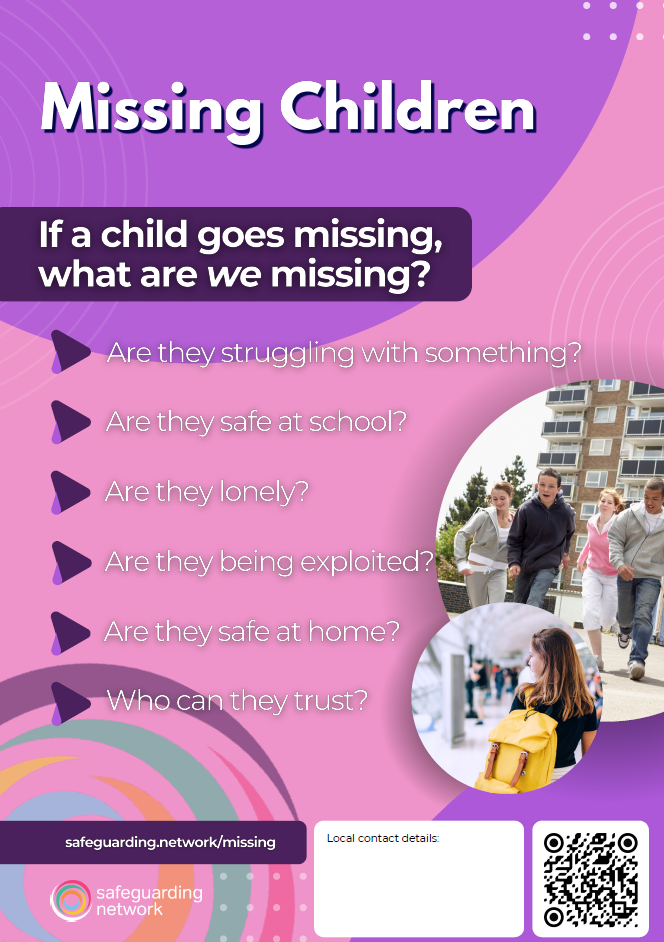Introduction
Children and young people can go missing for several reasons. Those who are missing, or have run away from home, are more likely to be absent from education.
Some missing incidents may simply be a result of a child breaking a curfew to see friends but children who are reported missing are often vulnerable to risk or already experiencing harm. Risk of harm or further harm is increased while they are missing, especially if they go missing more than once.
Need more?
Thank you for visiting our resources pages. These are free to everyone as is our fortnightly safeguarding bulletin – general safeguarding information is too important to restrict. Become a member to access lots more, including training materials for you to deliver in-house on each topic in Keeping Children Safe in Education.
Sign up for FREE fortnightly bulletin.
What about training?
We can deliver training for your setting on this and other subjects via online platforms, or face-to-face in certain areas. Just get in touch to discuss your requirements.
The reasons children go missing are varied and complex. Efforts to prevent children from going missing must, therefore, be wide-ranging, with a clear focus on the voice of the child and the reasons for them going missing. A safe home environment is the biggest protective factor to stop a child going missing, but safeguarding is everyone’s business and requires a collective response.
Definition of missing
“Anyone whose whereabouts cannot be established will be considered missing until located, and their well-being or otherwise confirmed.”
College of Policing, Authorised Professional Practice: Missing Persons
Prevalence
- According to the UKMPU Annual Data Report, 200,704 missing incidents involved children in 2022/2023.
- Missing People says 1-in-10 looked after children are reported missing compared to 1-in-200 children.
Why do children go missing?
Children and young people can go missing or run away for several reasons, usually because of a combination of push and pull factors.
Push factors
Things in the home that cause significant stress for the child or young person and lead them to believe that the only option to protect themselves is to leave.
Push factors can include:
- Parental issues – for example, parental substance misuse, parental mental health issues or domestic abuse within the home.
- Family conflict or breakdown – for example, numerous arguments in the home or a parent starting a new relationship with someone the child does not like.
- Abuse and/or bullying – being a victim of abuse may lead children and young people to believe that the only option is to run away from home.
- Loneliness – the child or young person may see going missing as a chance to meet new people and make new friends.
- Poverty - Children may be missing from home whilst they take part in paid employment.
- Poor mental health - some children do not feel supported in their home. Some children might seek to be away from adult supervision as part of plans to self-harm or act on suicidal thoughts.
Pull factors
Things that entice a child or young person to leave their home, usually believing that they can improve their lives in some way or meet an underlying need.
Pull factors can include:
- Criminal exploitation – for example, when a child is recruited to sell drugs as part of county lines.
- Sexual exploitation – a child may have been groomed and enticed to leave.
- Peer pressure.
- Excitement.
- Exploration – being in other environments may mean that a child or young person gets to explore issues such as relationships, sexuality or gender.
Risks
Children and young people who are missing may be in serious danger and are vulnerable to crime, abuse, sexual exploitation, criminal exploitation, abduction, radicalisation and missing education.
The report, The Ethnicity of Missing People, also demonstrates the need to remember that the risks are the same for children from all ethnic groups, and “…risks may be being under-identified for children from Black and Asian communities.”
Listen up and Missing People also report that Black young people feel undervalued and poor media representation results in Black missing children receiving less attention and care.
A child or young person who is going missing for prolonged and/or repeated occasions can be an early warning sign of potential safeguarding concerns.
Missing children and young people are at significant risk of underachieving and more likely not to be in education, employment or training in later life, thereby limiting their potential.
Additional vulnerabilities
Any child can potentially go missing, but some children are more likely to go missing than others:
Looked after children
According to the Department for Education, looked after children are more likely to go missing, and 1 in every 10 children in care is reported missing each year.
Many children and young people in care experience multiple placement moves, reducing the availability of relationships with safe and trusted adults.
It’s important that we are aware of the individual needs of looked after children and work to reduce the likelihood of missing incidents.
Trafficked and unaccompanied children
Trafficked and unaccompanied children are more likely to go missing than other children. Thousands of unaccompanied children currently live in accommodation that offers limited supervision and does not always meet their needs. Many go missing in the run up to their 18th birthday, possibly because they’re afraid of what will happen to their immigration status when they become adults.
LGBTQ+ children
Some LGBTQ+ children and young people may face bullying, discrimination and abuse at home due to their sexuality or perceived sexuality. They may feel the only way to escape is to run away from home.
Spot the signs
Early indicators that a child may potentially go missing include:
- being absent from education or regularly leaving early
- being seen in, or known to visit, areas they are not usually connected with
- being secretive/elusive
- avoiding attention
- parents or carers not knowing their exact whereabouts
- being seen in the community late at night or when they should be in education
- not attending arranged appointments
- being tired
- changes in behaviour and/or friendships
- they have gone missing before.
What to do
Our response when a child or young person goes missing is equally as important as understanding the reasons for them going missing.
There are two stages:
When a child is missing
Think about how much you know about the child, their friends, their likes and dislikes. Do they have any routines that they follow all the time, are there any favourite places they like to go? What do you know about the context in which they went missing? For example, was there a big argument immediately prior to the missing episode? Is there anything that may be drawing them away?
When reporting to the police, ensure you pass on all relevant details you know about the child, including any vulnerabilities and what you think may have led them to go missing, so officers can effectively complete the risk assessment that informs their response. For example, if a child had learning disabilities, and so was more vulnerable to harm, they would be considered at higher risk.
When a child returns
Think about how to respond appropriately. Try not to apportion blame – seek to understand what it might be like to be in their shoes and establish what might prevent a further missing episode.
What do you observe when they return: are they intoxicated (either through drink and/or drugs); are they wearing different clothes; are there any signs that they have been given money, phones, etc.? Are they tired? Do they have physical injuries?
It is the statutory responsibility of the local authority to ensure each missing child receives an Independent Return Home Interview, but they are sometimes delivered by a third sector partner. It’s important that education settings familiarise themselves with local safeguarding partnership protocols and procedures in relation to missing children.
Early action – offer the child or young person the chance to discuss their situation and how they feel. This may help them open up and ask for help.
Create a safeguarding culture - ensure children and young people feel secure and able to express their emotions and concerns, where they know they will be listened to, and can ask for the help they need.
Be proactive and robust when addressing any bullying and child-on-child abuse concerns reported in your setting, including those featuring sexual harassment and or sexual violence.
Children with additional needs and those who are known to social care services may require additional support and a targeted action plan, developed with their input, to help them feel empowered and build confidence in the setting’s ability to meet their individual needs.
Building partnerships with parents and carers
When working with parents and carers, practitioners should prioritise a child-centred approach, fostering partnerships to ensure understanding, support and safety.
Remember:
- Collaborative efforts are crucial, especially in cases of suspected harm.
- Practitioners must engage effectively with diverse families, demonstrating empathy, respect and cultural awareness.
- Communication should be clear, inclusive and accessible. Encouraging parental/carer involvement in decision-making and valuing their input is essential.
- Involving families and communities in designing processes fosters a holistic approach to safeguarding children.
- Continuous reflection and adaptation based on feedback from parents and carers enhance practice effectiveness.
- Have you considered if:
- parents and carers understand the importance of reporting missing from home incidents to the police in a timely manner?
- parents and carers need more support to understand and trust the role of the police and other services?
- exploitation is a factor when missing incidents occur and ensured that parent/carer views are considered clearly when completing any exploitation risk assessments and referrals?
- you should address push factors for a child at home during discussions with parents/carers and that referrals to support them are considered in a timely manner?
Free missing children poster
This free, downloadable resource raises the profile of safeguarding for your staff team. For use in staff rooms, on safeguarding boards or on the back of toilet doors, the poster includes tips, a space for local contact details, plus a link and QR codes to this resource page. Download the poster from the resources below.
DSL Training Materials
-

Presentation - Missing children
-

Missing children - Presenter Notes
-

Handout for staff - Missing children
-

Missing children – Quiz
-

Missing children – Quiz (Answer Sheet)
-

Missing children – whole group exercise
-

Missing children – whole group exercise – DSL sheet
-

Teenage Runaways in the UK
-

Missing children scenario (Early Years)
-

Missing children scenario (Early Years) – DSL information sheet
-

Missing children scenario (Primary)
-

Missing children scenario (Primary) – DSL information sheet
-

Missing children scenario (Secondary)
-

Missing children scenario (Secondary) – DSL Information Sheet
-

Missing children scenario (16+ settings)
-

Missing children scenario (16+) – DSL Information Sheet
-

Missing children scenario (SEND)
-

Missing children scenario (SEND) – DSL Information Sheet
-

Missing scenario – Care
-

Missing scenario (Care) – DSL information sheet
Resources
-

Missing children poster
-

Why Do Children Run Away?
-

Children Missing from Home
-

Research about Missing Children
-

Missing Children Response Assessment Tool
-

Centring the Child
-

The Ethnicity of Missing People
Save time and improve your safeguarding approach…
Bite-size training materials to share with your staff every month.
Support to explore and develop your safeguarding culture.
A huge array of resources and professional experience at your fingertips.
Get in touch now for a personal tour of the site and details of membership benefits.
We look forward to working with you.


